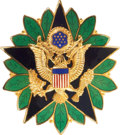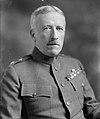Chief of Army Staff (Antilles)
| Chief of Army Staff of the United Commonwealth Army | |
|---|---|
 | |
 | |
| Department of the Army | |
| Abbreviation | COAS |
| Member of |
Joint Chiefs of Staff Army Staff |
| Reports to | Secretary of the Army |
| Residence | Fort Liberty, Columbia City, Hispaniola |
| Seat | National Military Center, Columbia City, Hispaniola |
| Appointer |
President Subject to approval by the Antillean Senate |
| Term length | Not fixed (typically 3–5 years) |
| First holder | George Ossoff |
| Deputy | Vice Chief of Army Staff |
The Chief of Army Staff is the highest-ranking uniform officer that serves as the head of the Antillean Army, being the principal military advisor to the Secretary of the Army. The Chief of Staff is always a four-star general (general of the army in the Antilles) and is in charge of all administrative aspects of maintaining the Army, including the organization, policy, doctrine, and planning, making the Chief of Staff "responsible to the President and the Secretary of the Army for the performance of the Army" (UCC). It is an administrative position with no operational control over Army units, but the Chief of Staff is tasked with maintaining the readiness of the force and providing Army forces to unified combatant commanders, who have operational command. The Chief of Army Staff is also a member of the Joint Chiefs of Staff and his working residence is Fort Liberty in Columbia City, which serves as the headquarters of the Army Staff.
The office of the Chief of Staff was created in 1925, first being subordinate to and later replacing entirely the position of Commanding General of the United Commonwealth Army, as part of military reforms in the years after the retreat of the Federalist government from the mainland. From 1925 until 1950 both posts were held by the same person, General George Ossoff, until his June 1950 coup attempt led to a reform of the Army senior leadership. The defeat of the Ossoff coup led the Army leadership to lose a significant amount of influence in the government, to the benefit of other branches and political factions. After 1950 the abolition of the post of Commanding General of the Army and the political effects of the coup meant that the Chief of Army Staff was made the head of the branch but was given a strictly administrative role, with no operational command over Army units.
Still, in the militarist one-party dictatorship developed by President Amelia Abarough (1921–1983) after the coup, the Chief of Army Staff and the Chief of Naval Staff continued to have a major influence on politics, and due to the constant threat of invasion by the Continental States, military planning and priorities tended to guide civilian government policy. The Chief of Staff was represented on the Executive Council by the Secretary of the Army, an office that was always an active-duty general during the Abarough administration. Since the end of the Abarough dictatorship in the 1980s and the democratization of the country, the Chief of Army Staff lost the vast majority of the political influence that the post had from the 1920s, and now has a more conventional role of setting Army policy and plans, coordinating with theater commanders, and overall maintaining the readiness and efficiency of the force. The principle of civilian control over the Armed Forces has been applied more stringently since the 1980s, although even in recent years it has been common for the Chief of Army Staff to openly comment on politics, something that is almost unheard of in most other Western democracies.
Responsibilities
Army Staff
The Army Staff is the headquarters staff that is directly subordinated to the Chief and is tasked with implementing policy across several departments. It is headquartered at Fort Liberty, in the Columbia City metro area, not far from the National Military Center.
- Chief of Army Staff
- Vice Chief of Army Staff
- Director, Army Staff
- Director, Personnel
- Director, Intelligence
- Director, Operations
- Director, Logistics
- Director, Communications
- Director, Strategy, Plans, and Policy
- Director, Force Structure
- Director, Joint Force Development
- Special Assistant to the Chief of Staff
- Director, Army Staff
- Vice Chief of Army Staff
List of chiefs
| No. | Holder | Took office | Left office | Time in office | Defence branch | Appointed by | |
|---|---|---|---|---|---|---|---|
| 1 | General of the Armies George Ossoff (1885–1952) | July 4, 1925 | June 16, 1951 | 25 years, 347 days | Infantry | Amelia Abarough | |
| 2 | General of the Army Albert Wedemeyer (1896–1989) | October 2, 1951 Acting: June 16, 1951 | July 15, 1958 | 6 years, 286 days | Armored forces | Amelia Abarough | |
| 3 | General of the Army Lloyd Kelly (1903–1994) | July 15, 1958 | September 7, 1964 | 6 years, 54 days | Field artillery | Amelia Abarough | |
| TBD | General of the Army Joseph Fenton (born 1946) | October 27, 2000 | January 25, 2004 | 3 years, 90 days | Infantry | George Abarough | |
| TBD | General of the Army Benjamin Key (born 1951) | January 25, 2004 | August 6, 2007 | 3 years, 193 days | Infantry | George Abarough | |
| TBD | General of the Army George Martin (born 1955) | August 6, 2007 | December 29, 2011 | 4 years, 145 days | Field artillery | William Abarough | |
| TBD | General of the Army David Sylvian (born 1957) | December 29, 2011 | February 1, 2016 | 4 years, 34 days | Armored forces | William Abarough | |
| TBD | General of the Army Michael Bailey (born 1962) | February 1, 2016 | March 3, 2020 | 4 years, 31 days | Infantry | Michael Abarough | |
| TBD | General of the Army Dennis Loewen (born 1966) | March 3, 2020 | 4 years, 227 days | Armored forces | Michael Abarough |
See also
| This page uses material from the Wikipedia page Chief of Staff of the United States Army, which is released under the Creative Commons Attribution-ShareAlike 3.0 Unported License (view authors). |









